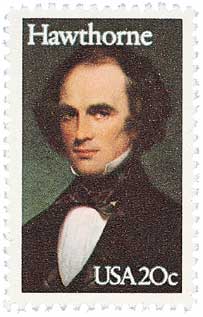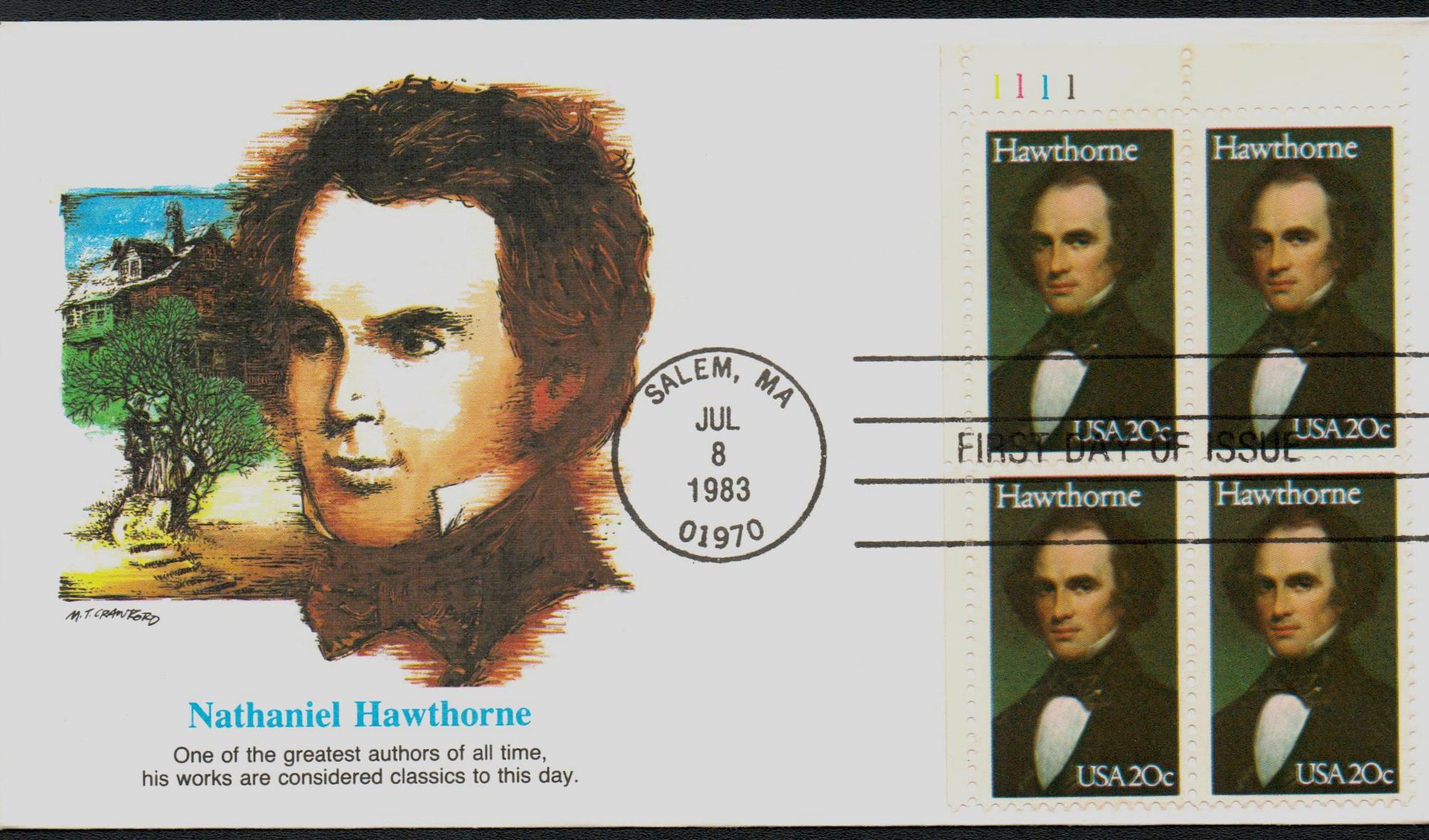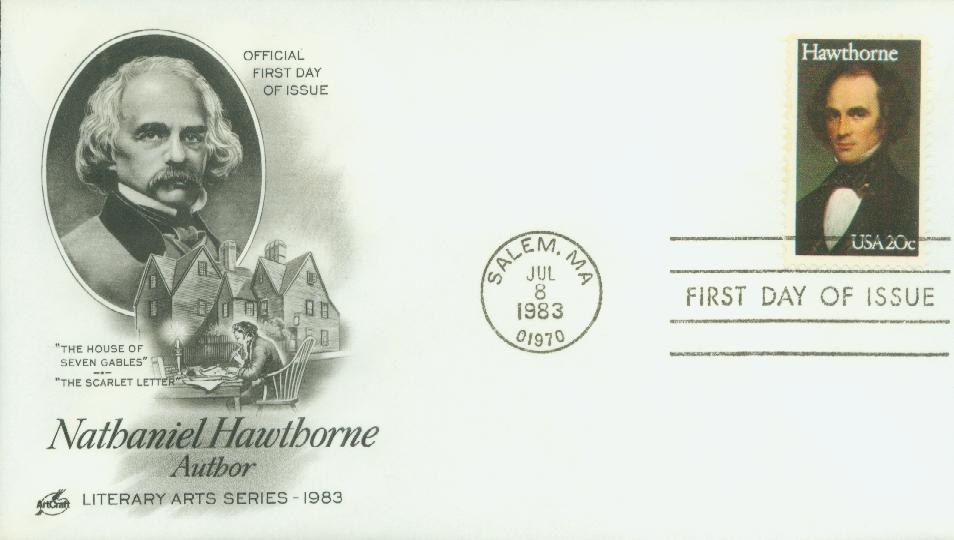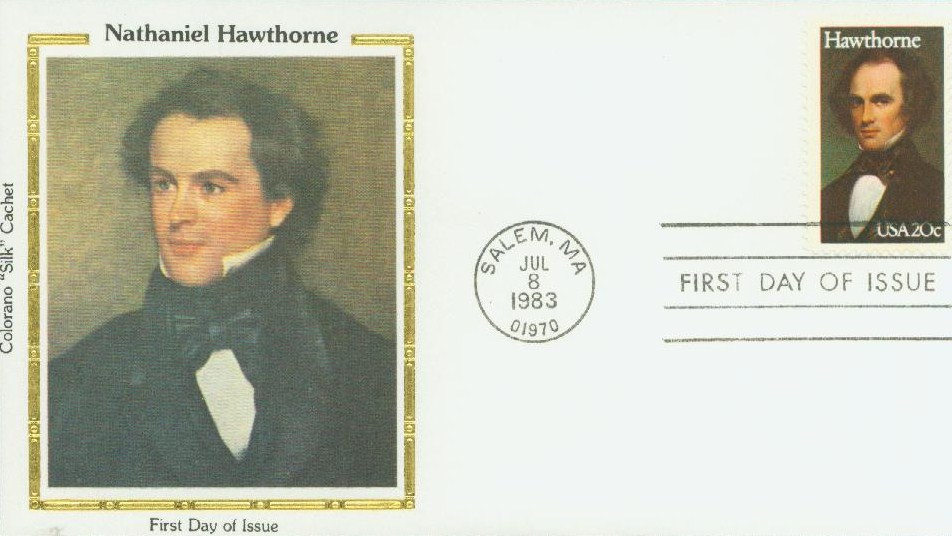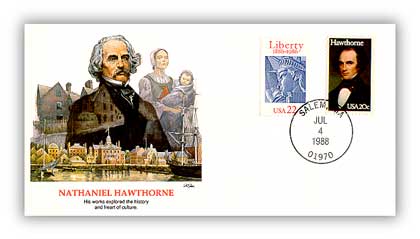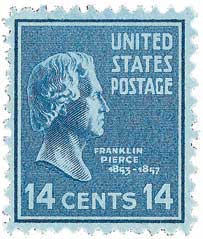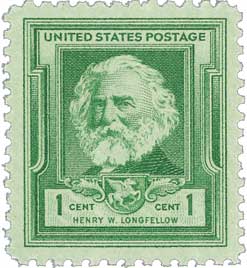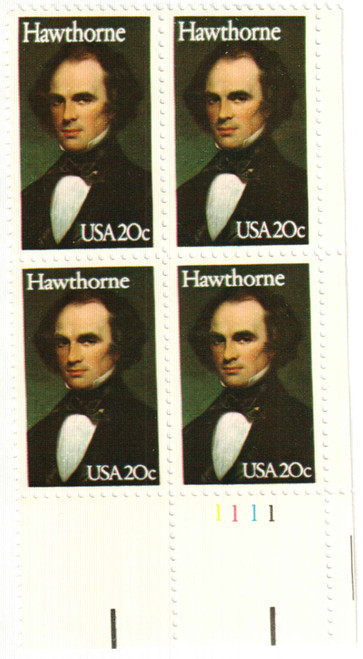
# 81903 - 1988 Nathaniel Hawthorne Cover
Death Of Nathaniel Hawthorne
Â
Â
Â
Â
Â
Â
American novelist Nathaniel Hawthorne died on May 19, 1864, while on a trip with former president Franklin Pierce to the White Mountains in New Hampshire.
Nathaniel Hawthorne was born on July 4, 1804, in Salem, Massachusetts.  In 1816, Hawthorne’s family moved to Maine. He greatly enjoyed his time there, saying they were “delightful days, for that part of the country was wild then, with only scattered clearings.â€
In his teens, Hawthorne produced a handwritten newspaper called The Spectator for his family, which featured his own essays, poems, and news stories. In 1821, Hawthorne’s uncle insisted he go to college, though Hawthorne didn’t want to. On his way to Bowdoin College, Hawthorne met future president Franklin Pierce, and the two began a life-long friendship. Hawthorne was an unenthusiastic student but graduated in 1825.
By 1836, Hawthorne was working as the editor for the American Magazine of Useful and Entertaining Knowledge. Some of his short stories were printed in magazines and annuals, but none earned him major recognition. Then in 1837, a friend offered to pay to have his works collected into a volume titled Twice-Told Tales, which earned him some local attention.Â
Â
Â
Â
Â
Â
Â
In the 1840s, Hawthorne worked in a customs house and as surveyor and inspector of the revenue in Salem. During these periods, he found it difficult to write. He also grew frustrated with politics, especially after he lost his job following a presidential election. He shared his feelings in a letter in the Boston Daily Advertiser and earned some local support.  Â
Â
Â
Â
Â
Â
Â
Hawthorne eventually found himself able to write again and in March 1850, he published The Scarlet Letter. It quickly became a best seller and sold 2,500 copies in 10 days. It also marked the start of the most productive and successful era of Hawthorne’s career. Later in 1850, Hawthorne befriended Herman Melville, who was writing Moby-Dick at the time. When published, he dedicated the story to Hawthorne “In token of my admiration for his genius.â€Â
Â
Â
Â
Â
Â
Â
Hawthorne followed his first success with another, The House of Seven Gables, in 1851. One critic said it was better than The Scarlet Letter and said it was “the most valuable contribution to New England history that has been made.† The book was partially based on the true story of a curse put on his family by a woman condemned to death during the Salem witch trials.
Â
Â
Â
Â
Â
Â
In 1853, Hawthorne purchased a home in Concord, Massachusetts, which he named The Wayside. While there, he wrote a biography of Franklin Pierce, who was running for president at the time. Hawthorne hoped it would help convince Americans that Pierce would make a good president, though Horace Mann said it was “the greatest work of fiction he ever wrote.â€
Â
Â
Â
Â
Pierce won that presidential election and made Hawthorne US consul in Liverpool in 1853. It was a highly prized position that Hawthorne enjoyed until Pierce’s administration ended in 1857. After spending some time in France and Italy, Hawthorne’s family returned home in 1860 and he published The Marble Faun.Â
Â
Â
Â
Â
By the 1860s, Hawthorne was in ill health, but in 1864, he wanted to go on a vacation with Pierce to the White Mountains in New Hampshire.  He died in his sleep during that trip on May 19, 1864. His longtime-friend Henry Wadsworth Longfellow wrote a poem in his honor in 1866, called “The Bells of Lynn.â€
Click here to view some of Hawthorne’s works.
Death Of Nathaniel Hawthorne
Â
Â
Â
Â
Â
Â
American novelist Nathaniel Hawthorne died on May 19, 1864, while on a trip with former president Franklin Pierce to the White Mountains in New Hampshire.
Nathaniel Hawthorne was born on July 4, 1804, in Salem, Massachusetts.  In 1816, Hawthorne’s family moved to Maine. He greatly enjoyed his time there, saying they were “delightful days, for that part of the country was wild then, with only scattered clearings.â€
In his teens, Hawthorne produced a handwritten newspaper called The Spectator for his family, which featured his own essays, poems, and news stories. In 1821, Hawthorne’s uncle insisted he go to college, though Hawthorne didn’t want to. On his way to Bowdoin College, Hawthorne met future president Franklin Pierce, and the two began a life-long friendship. Hawthorne was an unenthusiastic student but graduated in 1825.
By 1836, Hawthorne was working as the editor for the American Magazine of Useful and Entertaining Knowledge. Some of his short stories were printed in magazines and annuals, but none earned him major recognition. Then in 1837, a friend offered to pay to have his works collected into a volume titled Twice-Told Tales, which earned him some local attention.Â
Â
Â
Â
Â
Â
Â
In the 1840s, Hawthorne worked in a customs house and as surveyor and inspector of the revenue in Salem. During these periods, he found it difficult to write. He also grew frustrated with politics, especially after he lost his job following a presidential election. He shared his feelings in a letter in the Boston Daily Advertiser and earned some local support.  Â
Â
Â
Â
Â
Â
Â
Hawthorne eventually found himself able to write again and in March 1850, he published The Scarlet Letter. It quickly became a best seller and sold 2,500 copies in 10 days. It also marked the start of the most productive and successful era of Hawthorne’s career. Later in 1850, Hawthorne befriended Herman Melville, who was writing Moby-Dick at the time. When published, he dedicated the story to Hawthorne “In token of my admiration for his genius.â€Â
Â
Â
Â
Â
Â
Â
Hawthorne followed his first success with another, The House of Seven Gables, in 1851. One critic said it was better than The Scarlet Letter and said it was “the most valuable contribution to New England history that has been made.† The book was partially based on the true story of a curse put on his family by a woman condemned to death during the Salem witch trials.
Â
Â
Â
Â
Â
Â
In 1853, Hawthorne purchased a home in Concord, Massachusetts, which he named The Wayside. While there, he wrote a biography of Franklin Pierce, who was running for president at the time. Hawthorne hoped it would help convince Americans that Pierce would make a good president, though Horace Mann said it was “the greatest work of fiction he ever wrote.â€
Â
Â
Â
Â
Pierce won that presidential election and made Hawthorne US consul in Liverpool in 1853. It was a highly prized position that Hawthorne enjoyed until Pierce’s administration ended in 1857. After spending some time in France and Italy, Hawthorne’s family returned home in 1860 and he published The Marble Faun.Â
Â
Â
Â
Â
By the 1860s, Hawthorne was in ill health, but in 1864, he wanted to go on a vacation with Pierce to the White Mountains in New Hampshire.  He died in his sleep during that trip on May 19, 1864. His longtime-friend Henry Wadsworth Longfellow wrote a poem in his honor in 1866, called “The Bells of Lynn.â€
Click here to view some of Hawthorne’s works.




